
Exile is a series of role-playing video games created by Jeff Vogel of Spiderweb Software. They were released as shareware titles for Macintosh and Windows systems. Exile III was also ported to Linux by a third party. There were four games released in the series. All of the games were later revived in the Avernum series. Common to all games in the Exile series are 2D graphics and basic sound. The graphics in the first versions of Exile I and II had simple textures, colours and outlines, which were then replaced in later versions with Exile III's graphics. The games are designed to be non-linear and long in gameplay length.
Shareware is a type of proprietary software that is initially shared by the owner for trial use at little or no cost. Often the software has limited functionality or incomplete documentation until the user sends payment to the software developer. Shareware is often offered as a download from a website. Shareware differs from freeware, which is fully-featured software distributed at no cost to the user but without source code being made available; and free and open-source software, in which the source code is freely available for anyone to inspect and alter.

Escape Velocity is a single-player role-playing space trading and combat video game series first introduced in 1996 by Ambrosia Software for the Macintosh. Two other similar games based on the original, EV Override and Escape Velocity Nova, followed in 1998 and 2002 respectively, the latter of which is also available on Microsoft Windows. In addition there is a trading card game available based on the storyline of the EV Nova universe.
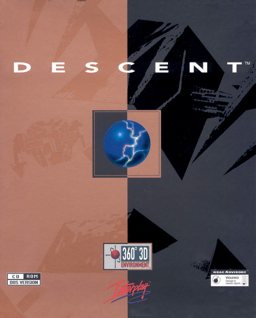
Descent is a first-person shooter (FPS) game developed by Parallax Software and released by Interplay Productions in 1995 for MS-DOS, and later for Macintosh, PlayStation, and RISC OS. It popularized a subgenre of FPS games employing six degrees of freedom and was the first FPS to feature entirely true-3D graphics. The player is cast as a mercenary hired to eliminate the threat of a mysterious extraterrestrial computer virus infecting off-world mining robots. In a series of mines throughout the Solar System, the protagonist pilots a spaceship and must locate and destroy the mine's power reactor and escape before being caught in the mine's self-destruction, defeating opposing robots along the way. Players can play online and compete in either deathmatches or cooperate to take on the robots.
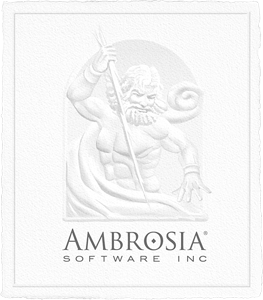
Ambrosia Software was a predominantly Macintosh software company founded in 1993 and located in Rochester, New York, U.S. Ambrosia Software was best known for its Macintosh remakes of older arcade games, which began with a 1992 version of Atari, Inc.'s Asteroids from 1979. The company also published utility software. Its products were distributed as shareware; demo versions could be downloaded and used for up to 30 days. Later the company released some products for iOS. Ambrosia's best-selling program was the utility Snapz Pro X, according to a 2002 interview with company president Andrew Welch.
Spiderweb Software is an independent video game developer founded in 1994 by Jeff Vogel in Seattle, Washington. Its primary focus is on creating demoware games for the Mac, Microsoft Windows, Android and the iPad. The games emphasize storytelling and turn-based gameplay and use a retro style of graphics.
Stunt Copter is a monochrome Macintosh action game written by Duane Blehm and published by his Kansas-based company, HomeTown Software, in 1986. Blehm's other games include Cairo Shootout, ZeroGravity, and PUZZ'L. He died unexpectedly in June 1988.

Maelstrom is a multidirectional shooter developed by Andrew Welch and released as shareware in November 1992 for Mac OS. The game is an enhanced clone of Atari, Inc.'s 1979 Asteroids arcade video game with a visual style similar to the Atari Games 1987 sequel, Blasteroids. Maelstrom was released when there were few action games for the high-resolution color displays of the Macintosh, and the game attracted attention despite the dated concept. The response led Welch to start Ambrosia Software.
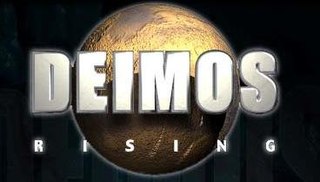
Mars Rising is a vertically scrolling shooter written by David Wareing and released as shareware by Ambrosia Software for Macintosh computers in 1998. Reviewers called out similarities to Xevious and Raiden. It was followed by Deimos Rising in 2001.

Apeiron is a Macintosh game developed and released as shareware by Ambrosia Software. An adaptation of the 1980 arcade game Centipede, it was first released on February 11, 1995. In November 2004, a Mac OS X port was made available.

Casady & Greene was a software publisher and developer active from 1988 to 2003. The company primarily released software for Macintosh, but also released software for Windows and Newton. Casady & Greene was formed in 1988 when Greene, Inc. acquired CasadyWare, a company owned by Robin Casady.
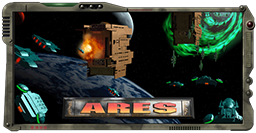
Ares is a space strategy video game created by Nathan Lamont of Bigger Planet Software, and first released by Changeling Software in 1998. In 1999 the game was re-released as shareware by Ambrosia Software and released as open source software and freeware in 2008. The key feature of the game was its ability to zoom in and out smoothly; this allowed the player to switch between a close-up view, which emphasized space combat skills, and a strategic view of the entire map.

Redline is a video game for Mac OS X developed by Jonas Echterhoff and published by Ambrosia Software. The game's primary features are its ability to simulate actual racing physics, online play, and support for the addition of third party content via plug-ins. The combination of these features have attracted numerous players and led to the creation of a seasonal racing league. Redline also has several modes of gameplay for those who prefer arcade style physics commonly found in other racing games. The game is now currently obsolete and an error message will be displayed upon opening the application as of OS X Snow Leopard and above. However, a fan-made patch allows the game to run on OS X Mavericks and above, but in single-player modes only.

Realmz is a fantasy adventure and role-playing video game first developed and published by Fantasoft in 1994 for the Apple Macintosh as shareware. Fantasoft released a Microsoft Windows-compatible version in 1999, and a science fiction role-playing game based on the Realmz engine, titled New Centurions, in 2001. Realmz was originally written by Tim Phillips on a Macintosh IIsi; he also wrote four game scenarios, including the introductory scenario "City of Bywater". Other original scenario contributors were Jim Foley and Sean Sayrs.

GooBall is a 2005 arcade-style puzzle video game developed by Over The Edge Entertainment for Mac OS X and published by Ambrosia Software. It is Over The Edge's first game, and runs on an early beta version of the Unity engine, which it was meant to showcase. Though it was highly downloaded, the game was commercially unsuccessful, leading Over The Edge to change its focus from making games, to making the Unity engine.

Pillars of Garendall is a role-playing video game that was built by Beenox Studios and Ambrosia Software. It was built using the Coldstone game engine, which was also a joint Beenox/Ambrosia project. The game was released in 2001 for Mac OS Classic, Microsoft Windows and Mac OS X.
SketchFighter 4000 Alpha is a scrolling shooter with a focus on exploration for Mac OS X. The game was created by Lost Minds together with Ambrosia Software. SketchFighter uses OpenGL and a custom game engine to create visuals for all elements of the game reminiscent of hand-drawn sketches.
Escape Velocity Override is a space trading simulator game written by Peter Cartwright, with the support of his school-friends, and developed by Ambrosia Software for the Apple Macintosh. It is the sequel to Escape Velocity with an extended version of the original game engine, but Override has an entirely new story line set in a different, larger universe.

Radical Castle is a point-and-click adventure game released for Macintosh in 1986, developed in World Builder and distributed as shareware by Christopher Kent Wigginton.
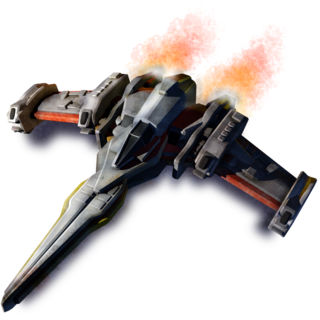
Endless Sky is a space trading and combat simulation video game, created by Michael Zahniser and first released in June 2015. In Endless Sky, the player starts out as a spaceship captain and can trade, transport passengers or fight pirates to earn money. There are also a few story lines that the player can choose to participate in. The game is similar to games in the Escape Velocity series.














